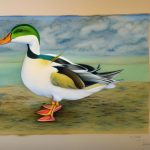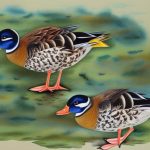The 2019 Duck Breeding Report provides a comprehensive analysis of the current state of duck breeding populations in North America. This report is a crucial tool for wildlife managers, conservationists, and policymakers to understand the trends and challenges facing duck populations and to develop effective strategies for their conservation. The report is based on extensive surveys conducted by the U.S. Fish and Wildlife Service and Canadian Wildlife Service, which provide valuable data on duck breeding populations, habitat conditions, and nesting success. By examining the findings of this report, we can gain insights into the health of duck populations and the factors influencing their breeding success.
Key Takeaways
- The 2019 Duck Breeding Report provides valuable insights into the population trends and habitat conditions for ducks.
- Duck breeding population trends show both positive and negative changes in different regions, highlighting the need for targeted conservation efforts.
- Analysis of duck breeding habitat and nesting success reveals the importance of maintaining and improving wetland areas for successful reproduction.
- Environmental factors such as weather patterns and land use have a significant impact on duck breeding success, emphasizing the need for sustainable land management practices.
- Comparison of duck breeding numbers to previous years indicates fluctuations in population size, underscoring the importance of ongoing monitoring and conservation efforts.
- The 2019 Duck Breeding Report has important implications for conservation efforts, highlighting the need for targeted habitat protection and management to support duck populations.
- Future considerations for duck breeding management should focus on addressing the impact of climate change, habitat loss, and other threats to ensure the long-term sustainability of duck populations.
Overview of Duck Breeding Population Trends
The 2019 Duck Breeding Report reveals both positive and concerning trends in duck breeding populations. Overall, the report indicates a stable population of breeding ducks, with an estimated 38.9 million ducks in the surveyed area. This represents a slight decrease from the previous year, but it is still within the long-term average. Mallards, the most abundant duck species, showed a slight decline in population, while other species such as gadwalls and green-winged teal experienced increases. These fluctuations in population numbers highlight the dynamic nature of duck breeding populations and the importance of ongoing monitoring and conservation efforts.
The report also provides valuable insights into regional population trends, with some areas experiencing declines in breeding duck numbers while others show increases. For example, the Prairie Pothole Region, known as the “duck factory” due to its importance for breeding waterfowl, saw a decrease in duck populations compared to the previous year. In contrast, the boreal forest region of Canada experienced an increase in breeding duck numbers. These regional variations underscore the need for targeted conservation efforts that address specific habitat challenges and environmental factors affecting duck populations.
Analysis of Duck Breeding Habitat and Nesting Success
The 2019 Duck Breeding Report includes an analysis of duck breeding habitat and nesting success, providing critical information on the factors influencing duck population trends. The report highlights the importance of wetland habitats for breeding ducks, as these areas provide essential resources for nesting and rearing young. The survey data indicates that wetland conditions have a significant impact on nesting success, with ducks showing higher nesting success in areas with abundant wetland habitat. This underscores the importance of preserving and restoring wetland ecosystems to support healthy duck populations.
In addition to wetland habitat, the report also examines the impact of upland nesting cover on duck breeding success. Upland nesting cover, such as grasslands and shrublands, provides crucial nesting sites for ducks and contributes to their overall reproductive success. The report identifies the loss of upland nesting cover as a significant challenge for duck populations, particularly in agricultural landscapes where habitat conversion and fragmentation are common. By understanding the relationship between nesting habitat and breeding success, conservationists can prioritize efforts to protect and enhance critical nesting areas for ducks.
Impact of Environmental Factors on Duck Breeding
The 2019 Duck Breeding Report delves into the impact of environmental factors on duck breeding success, shedding light on the challenges posed by climate change, extreme weather events, and habitat degradation. The report highlights the vulnerability of duck populations to environmental changes, with shifts in precipitation patterns and temperature affecting wetland conditions and nesting habitat. These environmental factors can influence duck breeding success by altering food availability, water levels, and nesting site quality, ultimately impacting population dynamics.
Furthermore, the report emphasizes the role of human activities in shaping environmental conditions for breeding ducks. Habitat loss and degradation due to agriculture, urban development, and infrastructure projects pose significant threats to duck populations, reducing the availability of suitable nesting habitat and food resources. Pollution and contamination of wetlands also have detrimental effects on duck breeding success, highlighting the need for sustainable land use practices and conservation measures to mitigate these impacts.
Comparison of Duck Breeding Numbers to Previous Years
The 2019 Duck Breeding Report provides a valuable comparison of duck breeding numbers to previous years, offering insights into long-term population trends and fluctuations. While the overall breeding duck population showed a slight decrease compared to the previous year, it is important to consider these numbers in the context of historical data. The report indicates that breeding duck numbers remain within the long-term average, demonstrating resilience in the face of environmental challenges and human impacts.
By comparing breeding numbers over multiple years, the report allows researchers and conservationists to identify patterns and trends in duck populations, enabling them to assess the effectiveness of conservation efforts and adapt management strategies accordingly. This long-term perspective is essential for understanding the dynamics of duck breeding populations and for making informed decisions to support their conservation.
Implications of the 2019 Duck Breeding Report for Conservation Efforts

The 2019 Duck Breeding Report has significant implications for conservation efforts aimed at protecting duck populations and their habitats. The findings of the report underscore the importance of preserving and restoring wetland habitats, as well as upland nesting cover, to support healthy breeding duck populations. Conservation initiatives focused on enhancing wetland conditions, reducing habitat loss, and implementing sustainable land management practices are critical for ensuring the long-term viability of duck populations.
Furthermore, the report highlights the need for collaborative conservation efforts that address regional variations in duck breeding populations and habitat conditions. By working across borders and jurisdictions, conservationists can develop coordinated strategies to protect key breeding areas and address common threats to duck populations. The report also emphasizes the importance of engaging with stakeholders, including landowners, farmers, and local communities, to promote conservation practices that benefit both ducks and people.
Future Considerations for Duck Breeding Management
Looking ahead, the 2019 Duck Breeding Report points to several key considerations for duck breeding management that will be crucial for ensuring the conservation of these important waterfowl species. One such consideration is the need to adapt conservation strategies in response to changing environmental conditions and habitat dynamics. As climate change continues to impact wetland ecosystems and nesting habitats, conservation efforts must be flexible and adaptive to address emerging challenges.
Another important consideration is the integration of science-based management approaches that prioritize evidence-based decision-making and monitoring of duck populations. By leveraging scientific research and monitoring data, wildlife managers can implement targeted conservation actions that address specific threats to duck breeding success. Additionally, continued collaboration between government agencies, non-profit organizations, and research institutions will be essential for advancing research, sharing best practices, and coordinating conservation efforts across landscapes.
In conclusion, the 2019 Duck Breeding Report provides valuable insights into the status of duck breeding populations, habitat conditions, and environmental factors influencing their reproductive success. By analyzing this report, conservationists can develop informed strategies to protect and conserve duck populations for future generations. Through collaborative efforts and adaptive management approaches, we can work towards ensuring healthy and sustainable duck breeding populations across North America.
In a recent 2019 duck breeding report, experts have highlighted the importance of providing a suitable coop and run for ducks to thrive. This is in line with the recommendations made in a related article on PoultryWizard.com, which offers comprehensive chicken coop and run plans. The article emphasizes the significance of creating a comfortable and secure environment for poultry, including ducks. To learn more about creating the ideal coop and run for your ducks, check out the insightful article on PoultryWizard.com.
FAQs
What is the purpose of the 2019 duck breeding report?
The purpose of the 2019 duck breeding report is to provide an overview of the breeding success and population trends of ducks in a specific area or region during the year 2019.
What information is included in the 2019 duck breeding report?
The report typically includes data on the number of breeding pairs, nesting success, brood survival, and overall population estimates for various duck species. It may also include information on habitat conditions, environmental factors, and management efforts that may have impacted duck breeding success.
Who compiles the 2019 duck breeding report?
The report is typically compiled by wildlife agencies, conservation organizations, or research institutions that are responsible for monitoring and managing duck populations. These entities often conduct surveys and research to gather the necessary data for the report.
How is the data for the 2019 duck breeding report collected?
Data for the report is collected through various methods, including aerial surveys, ground-based surveys, nest monitoring, and banding studies. Researchers and wildlife biologists often use standardized protocols to ensure consistency and accuracy in the data collection process.
Why is the 2019 duck breeding report important?
The report is important because it provides valuable information for wildlife management and conservation efforts. It helps to assess the health of duck populations, identify trends and potential threats, and inform decision-making related to habitat management, hunting regulations, and other conservation measures.
Meet Walter, the feathered-friend fanatic of Florida! Nestled in the sunshine state, Walter struts through life with his feathered companions, clucking his way to happiness. With a coop that’s fancier than a five-star hotel, he’s the Don Juan of the chicken world. When he’s not teaching his hens to do the cha-cha, you’ll find him in a heated debate with his prized rooster, Sir Clucks-a-Lot. Walter’s poultry passion is no yolk; he’s the sunny-side-up guy you never knew you needed in your flock of friends!







